|
December 8, 2008
O&A Out Again in Boston
*The last time the Opie and Anthony Show
was pulled from the airwaves of eastern MASSACHUSETTS,
back in 1998, it was big headline news: the then-WAAF (107.3)
morning team had staged an April Fool's Day prank in which they
claimed Boston mayor Tom Menino had been killed in a car crash.
 The duo kept making
headlines after that - they moved on to a high-profile morning
slot at New York's WNEW (102.7), then lost that job (including
a syndication deal that landed them back in Boston on WBCN) in
2002 after the infamous "Sex for Sam" incident. The duo kept making
headlines after that - they moved on to a high-profile morning
slot at New York's WNEW (102.7), then lost that job (including
a syndication deal that landed them back in Boston on WBCN) in
2002 after the infamous "Sex for Sam" incident.
Two years later, though, O&A were back on the air in both
New York (at WXRK 92.3) and Boston (at WBCN) with a partial simulcast
of their XM Radio morning show - and there the matter rested,
at least until last week.
The new lineup at WBCN moves Toucher & Rich from afternoons
into morning drive and Hardy from evenings to afternoons. Music
director Dan O'Brien gets an airshift out of the deal, too, taking
over the 7-midnight slot, presumably with the assistance of voicetracking.
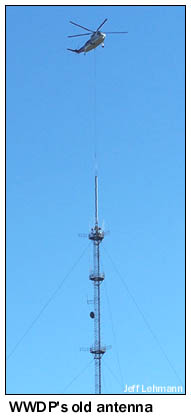 *Where's
"Baptist Village, Massachusetts"? That's what we were
wondering when we noted that the FCC has granted a construction
permit to Morgan Brook Christian Radio for a 40-watt/384' class
A signal on 89.5 there, which now has the calls WJCI. (The answer,
as it turns out, is just east of East Longmeadow, southeast of
Springfield, though the new WJCI will fight with Westfield's
co-channel WSKB to be heard in Springfield proper.) *Where's
"Baptist Village, Massachusetts"? That's what we were
wondering when we noted that the FCC has granted a construction
permit to Morgan Brook Christian Radio for a 40-watt/384' class
A signal on 89.5 there, which now has the calls WJCI. (The answer,
as it turns out, is just east of East Longmeadow, southeast of
Springfield, though the new WJCI will fight with Westfield's
co-channel WSKB to be heard in Springfield proper.)
On the TV front, ShopNBC affiliate WWDP has temporarily silenced
its digital signal as it prepares for transition day in February.
It took a helicopter last Tuesday to remove WWDP-DT's channel
52 antenna from its tower in West Bridgewater, replacing it with
a new antenna for the Norwell-licensed station's new channel
10 digital signal. But there's a catch: because channel 10 remains
in use by WJAR's analog signal in Providence, WWDP-DT won't be
able to start using its new channel until February 18. So it's
off the air digitally, though it remains on the air in analog
(on channel 46) from a nearby tower site until transition day.
(And thanks to Jeff Lehmann for sharing his photos of the
antenna replacement - you can see more pics here
and video here
and here!)
Where are they now? Former WRKO (680) talker Jeff Katz has
parted ways with his most recent employer, WBT in Charlotte,
North Carolina. The Greater Media-owned station abruptly cancelled
Katz' show last week, replacing him with evening talk host Tara
Servatius. (And in an unrelated coincidence, WBT's transmitter
site is our feature on this week's Tower
Site of the Week...)
Robert DeLaney won't be remembered by Red Sox fans with the
same reverence as, say, Curt Gowdy (who'll be inducted into the
Sports Broadcasting Hall of Fame later this month) - but the
central New York native, who died Nov. 25 in Queens, N.Y. at
84, did work alongside Gowdy for three seasons (1951-53) at Fenway.
DeLaney, a native of Elmira and graduate of Syracuse University,
came to the Sox and then-flagship WHDH from WFBL in Syracuse.
DeLaney also worked some Boston Braves games before heading down
to New York and the Giants broadcast booth, where he replaced
the soon-to-be-legendary-in-Detroit Ernie Harwell. Delaney stayed
east when the Giants moved west, and ended up working for the
Yankees, the John F. Kennedy campaign, and later for WFAS in
White Plains before retiring in the seventies.
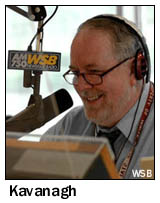 And
Mike Kavanagh, who worked at WHYN (560 Springfield) back in the
seventies, has died far too young. Kavanagh went from Springfield
to WLEE in Richmond, Virginia, then to WASH in Washington, DC,
to RKO Radio in New York - and eventually ended up in Atlanta,
first at CNN Radio News and then at WSB (750). Kavanagh scaled
back his duties at WSB a few years ago to focus on his new career
as a financial advisor, but continued to host the station's Sunday
"Money Matters" show. The UMass graduate (and alumnus
of campus station WMUA) suffered a fatal heart attack Saturday
(Dec. 6) as he was decorating the Christmas tree in his suburban
Alpharetta home; it was his 57th birthday. And
Mike Kavanagh, who worked at WHYN (560 Springfield) back in the
seventies, has died far too young. Kavanagh went from Springfield
to WLEE in Richmond, Virginia, then to WASH in Washington, DC,
to RKO Radio in New York - and eventually ended up in Atlanta,
first at CNN Radio News and then at WSB (750). Kavanagh scaled
back his duties at WSB a few years ago to focus on his new career
as a financial advisor, but continued to host the station's Sunday
"Money Matters" show. The UMass graduate (and alumnus
of campus station WMUA) suffered a fatal heart attack Saturday
(Dec. 6) as he was decorating the Christmas tree in his suburban
Alpharetta home; it was his 57th birthday.
*CBS Radio's financial woes led to more cutbacks
early last week in NEW YORK, as the cluster's management
went through yet another streamlining - and the future of Opie
and Anthony's Big Apple broadcast home base was left hanging.
This time, the CBS axe claimed the jobs of most of the management
team at WXRK (92.3), as PD/music director Mike Tierney and general
sales manager Steve Townsend were cut completely, while GM Maire
Mason stayed employed, albeit in Townsend's old job. Don Bouloukos,
CBS Radio's senior VP/market manager, will serve as K-Rock's
GM, while Mark Chernoff, the cluster's VP/programming, will handle
PD duties. (And yes, the usual "no format changes are planned"
denial was quickly forthcoming.)
There's more: over at WINS (1010), Greg Janoff lost his GM
post, becoming that station's general sales manager as Steve
Swenson adds WINS GM duties to his existing GM role at WCBS (880).
And there's still more: there's word that the oft-delayed
project to move most of the cluster to new studios in lower Manhattan
will now include not only WINS and WWFS (moving from 888 Seventh
Ave.), WFAN (moving from Astoria, Queens) and WCBS-FM (moving
from temporary digs with WXRK at 40 W. 57th Street) - now WCBS(AM)
is ticketed to move downtown as well. Since the all-news station's
current digs on the eighth floor of the CBS Broadcast Center
at 524 W. 57th Street are in CBS-owned property, could there
be some consolidation of the once-competitive WINS and WCBS operations
in the works? Will WXRK, still not included in the Hudson Street
plans, eventually be targeted for the downtown train as well
- assuming it doesn't follow the lead of CBS' San Francisco cluster
and wind up as, say, WINS-FM or WFAN-FM? (Monday update -
We're told WXRK was in fact quietly added to the move back in
September.) And what ever became of former CBS Radio honcho
Mel Karmazin's theory that the best way to run a cluster in a
big market is with completely separate studios and sales staffs,
anyway?
With the demise of Bill O'Reilly's syndicated talk show, New
York's WOR (710) will rework its entire daytime schedule after
New Year's Day: local host Joan Hamburg will move to 11 AM, making
way for a live clearance for Glenn Beck in market #1 from 9-11.
WOR's long-running "Food Talk," which had been heard
from 11-noon, gets bumped to a weekend-only slot. Hamburg's new
11-1 slot takes one of the hours from O'Reilly's former noon-2
clearance; Dr. Joy Browne will fill the 1-2 PM hour (as well
as her existing 9-11 PM clearance), and Dennis Miller is out
of the 2-4 PM slot, replaced by Lou Dobbs' new syndicated talk
show.
(What will become of some of O'Reilly's other prominent clearances,
on big NERW-land talkers such as Boston's WTKK and Philly's WPHT?
Stay tuned as the show's actual last day, sometime "in the
first quarter of 2009," draws nearer...)
 On the
HD Radio front, we've long maintained that public radio is about
the only remaining source of programming innovation, and Fordham's
WFUV (90.7 New York) is helping to make that case. "The
Alternate Side" is WFUV's latest additional programming
stream, running on WFUV's HD3 channel and on the web at thealternateside.org.
The new channel is devoted to emerging local artists in the New
York market, and much of its funding is coming from the settlement
money former governor Eliot Spitzer extracted from the recording
and radio industries during his payola investigations. (For non-HD-equipped
listeners, The Alternate Side also airs on WFUV's main signal
for a few hours at 10 PM on Fridays...) On the
HD Radio front, we've long maintained that public radio is about
the only remaining source of programming innovation, and Fordham's
WFUV (90.7 New York) is helping to make that case. "The
Alternate Side" is WFUV's latest additional programming
stream, running on WFUV's HD3 channel and on the web at thealternateside.org.
The new channel is devoted to emerging local artists in the New
York market, and much of its funding is coming from the settlement
money former governor Eliot Spitzer extracted from the recording
and radio industries during his payola investigations. (For non-HD-equipped
listeners, The Alternate Side also airs on WFUV's main signal
for a few hours at 10 PM on Fridays...)
There's some HD Radio technical innovation to report, too,
and it also comes from public radio: WEOS (89.7 Geneva) has turned
on what GM Aaron Read claims to be the first HD-enabled translator
in the country. W212BA (90.3 Geneva) is using a new Larcan translator
that frequency-shifts the entire incoming signal from the main
WEOS transmitter, including the HD sidebands, and even at reduced
power (48 watts instead of 88, while WEOS awaits a more powerful
new model from Larcan), Read says the new translator is providing
reliable digital service over the Hobart and William Smith campus
and the city of Geneva for the first time.
There's an ownership change in eastern Long Island, where
Ron Morey is cashing out his interest in two of Jarad Broadcasting's
three stations. WBON (98.5 Westhampton) and WDRE (105.3 Calverton-Roanoke)
go to the new "JVC Broadcasting," a partnership between
Jarad co-owner John Caracciolo and programmer Vic "Latino"
Canales, in a deal that Inside Radio is reporting to be
valued at about $1.75 million. That's a far cry from the $60
million Morey realized when he sold his original Jarad station,
WLIR (92.7 Garden City) to Univision Radio back in 2004. (The
current WLIR, 107.1 Hampton Bays, remains in Morey's hands for
now; it's LMA'd to ESPN, which relays New York's WEPN 1050 on
the East End signal with an option to buy it outright.)
Up north, there's a format change at WIRD (920 Lake Placid)
- on November 26 at noon, it flipped from ESPN Radio to a simulcast
of news-talk sister station WNBZ (1240 Saranac Lake). WIRD's
morning show remains unchanged, since it was already doing a
simulcast with WNBZ, WLPW (105.5 Lake Placid) and WRGR (102.3
Tupper Lake) in morning drive.
There's a new PD at Buffalo's WJYE (96.1), as the Regent station
brings Chuck Stevens home from Pittsburgh and WLTJ (92.9). Stevens
starts next week at the station, freeing morning man (and cluster
operations manager) Joe Chille from programming duties.
Where are they now? Dave Symonds, who launched his radio management
career in Rochester as operations manager at Entercom, has moved
from Entercom's Denver cluster (where he was PD of KOSI and KALC)
to Clear Channel in Richmond, Virginia, where he's programming
WTVR (98.1) and serving as operations manager for the cluster.
Galaxy is shifting simulcasts on an Oswego translator. W291BU
(106.1 Fulton) was relaying classic rock WTKV (105.5 Oswego)
for the last few months, with a signal that sometimes carried
the 60 miles or so over to NERW Central here in Rochester; now
it's relaying Galaxy's WZUN (102.1 Phoenix) instead, extending
the reach of "Sunny 102" north into Oswego County.
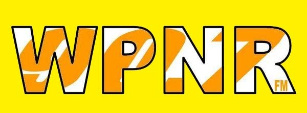 Over in Utica, WPNR
(90.7) is making peace with the FCC after a series of problems
with its public file. When the Utica College station applied
(belatedly) for its last license renewal in 2006, it admitted
that most of its quarterly issues lists were missing, not to
mention the required coverage map and ownership reports. The
problems have been fixed - but a consent decree between the college
and the FCC will lead to a $10,000 "voluntary contribution"
and a compliance plan to make sure things go more smoothly during
the next license term. (Number of people who asked to see WPNR's
public file during the last license term? Zero.) Over in Utica, WPNR
(90.7) is making peace with the FCC after a series of problems
with its public file. When the Utica College station applied
(belatedly) for its last license renewal in 2006, it admitted
that most of its quarterly issues lists were missing, not to
mention the required coverage map and ownership reports. The
problems have been fixed - but a consent decree between the college
and the FCC will lead to a $10,000 "voluntary contribution"
and a compliance plan to make sure things go more smoothly during
the next license term. (Number of people who asked to see WPNR's
public file during the last license term? Zero.)
In TV news, Liberman Broadcasting is moving east. The Spanish-language
broadcaster, best known for its independent stations in Los Angeles
and Houston, is buying WASA-LP from Venture Technologies. What's
WASA-LP? Right now, it's a low-power signal on channel 64 in
Port Jervis - but it holds a construction permit to move to channel
25 and broadcast digitally from the 4 Times Square tower in Manhattan.
Meanwhile, Time Warner Cable is moving west with its web of
all-news cable channels upstate. Albany's Capital News 9, Syracuse's
News 10 Now and Rochester's R News will be getting a Buffalo-based
sibling next year, to be seen on the western New York systems
Time Warner picked up in the collapse of Adelphia. There's no
word yet on the new channel's name or dial position - or on how
much of its content will come from the hubs that already allow
the existing upstate channels to share weather forecasts, news
reports and even anchors.
|
SEE THAT 2008 CALENDAR ON
THE WALL? IT WILL BE OBSOLETE BEFORE YOUR ANALOG TV SET IS...
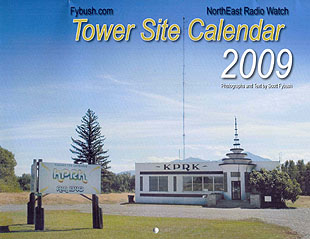 And while we don't have a government coupon program
to bail you out, we have an excellent, and equally inexpensive,
solution: And while we don't have a government coupon program
to bail you out, we have an excellent, and equally inexpensive,
solution:
Replace that soon-to-be-historic 2008 model
with the brand new 2009 Tower Site Calendar before
the new year arrives!
Order
now at the fybush.com Store! |
*The management shuffle hit eastern PENNSYLVANIA
pretty hard last week. At Greater Media, Bob DeBlois' position
as station manager at WPEN (950 Philadelphia) was eliminated,
leaving him without a job. Over at CBS Radio, there are now just
two managers in charge of all five stations in the cluster: Marc
Rayfield adds GM duties at KYW (1060) to his existing GM role
at WPHT (1210) and WIP (610) - and his market manager responsibilities
over the whole cluster; Jim Loftus is now overseeing WOGL (98.1)
and WYSP (94.1).
A format change in Scranton: WNAK (730 Nanticoke)/WCDL (1440
Carbondale) have dropped their Spanish-language programming and
are back to standards, with an all-Christmas bent at the moment.
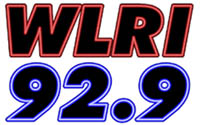 Callsign alert! WLRI-LP
(92.9 Gap) has changed calls yet again. It's now WRLY-LP, or
at least it will be if it returns to the air. After 18 call changes
in just over five years (and the WRLY change makes it 19), the
station filed for special temporary authority to remain silent
back in October. Incidentally, while the station's website
claims it's the "first and only" LPFM in the country
to experiment with HD Radio, that's not quite so - we had the
privilege last month of visiting an LPFM station in Indiana that's
already experimented with HD and is planning to fire it up permanently
next year. (That would be WIOE-LP 98.3 in Warsaw, which has found
community support and success despite having only ever had a
single set of call letters...) Callsign alert! WLRI-LP
(92.9 Gap) has changed calls yet again. It's now WRLY-LP, or
at least it will be if it returns to the air. After 18 call changes
in just over five years (and the WRLY change makes it 19), the
station filed for special temporary authority to remain silent
back in October. Incidentally, while the station's website
claims it's the "first and only" LPFM in the country
to experiment with HD Radio, that's not quite so - we had the
privilege last month of visiting an LPFM station in Indiana that's
already experimented with HD and is planning to fire it up permanently
next year. (That would be WIOE-LP 98.3 in Warsaw, which has found
community support and success despite having only ever had a
single set of call letters...)
In Coudersport, Cary Simpson's Allegany Mountain Network has
completed its station selloff: after parting with WFRM-FM (96.7),
which is moving over to Backyard's cluster in the Olean, NY market,
it's now WFRM (600)'s turn to be sold. The AM stays local, going
to David and Cathy Lent's L-Com, which also owns WHKS (94.9)
in nearby Port Allegany. Sale price on this one: $200,000 - and
mark down Pittsburgh's Ray Rosenblum as the rare broker who's
still getting some deals done in this challenging market.
Also being sold up that way is Frank Iorio's WNAE-FM (102.7
Clarendon). The Warren-area FM goes to Larry Schrecongost's Vernal
Enterprises for $355,000, joining Vernal's small cluster of stations
to the south in the Altoona/Johnstown area.
Where are they now? Former WCAT-FM (102.3 Carlisle) PD/afternooner
Will Robinson has moved south to WFRE in Frederick, Maryland
for middays, reports AllAccess. Robinson will also be
music director at the Clear Channel country outlet.
*More staffing changes at Millennium's NEW
JERSEY stations: four staffers are out at WCHR-FM (105.7
Manahawkin), including "Dr. Phil" Locascio, who was
the station's operations manager and Millennium's director of
rock programming. Race, who'd been APD and middayer at "The
Hawk," takes over Locascio's afternoon shift and his programming
duties, and the station is looking for a new midday jock.
Over at Press Communications on the shore, WKMK (98.5 Ocean
Acres) PD/morning man Brian Moore is out of work after his position
was eliminated. Part-timer Kris McNeil takes over the morning
show; station manager Mike Fitzgerald is handling PD responsibilities
at "K-98.5."
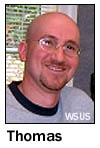 Sad
news from Clear Channel's cluster in northwest New Jersey: operations
manager and WSUS (102.3 Franklin) afternoon jock Vince Thomas
lost his long battle with a rare form of cancer early last Tuesday
morning (December 3). Thomas, whose real name was Vincent Toscano,
was still in his teens when he started at WNNJ (1360 Newton)
in 1990. He'd been a fixture at WSUS for more than a decade,
though he'd been off the air for nearly two years as his illness
worsened. He was just 37. Sad
news from Clear Channel's cluster in northwest New Jersey: operations
manager and WSUS (102.3 Franklin) afternoon jock Vince Thomas
lost his long battle with a rare form of cancer early last Tuesday
morning (December 3). Thomas, whose real name was Vincent Toscano,
was still in his teens when he started at WNNJ (1360 Newton)
in 1990. He'd been a fixture at WSUS for more than a decade,
though he'd been off the air for nearly two years as his illness
worsened. He was just 37.
*In CONNECTICUT, it's apparently back
to the satellite in afternoon drive at Clear Channel's WELI (960
New Haven), where we hear that a third hour of Sean Hannity and
an hour of John Gibson are now being heard from 5-7 PM in place
of Ryan Gorman, who'd been doing both the morning show up at
sister station WKSS (95.7 Hartford) and the afternoon talk shift
in New Haven.
 Edited by NERW's own Scott Fybush - on sale now as
an e-book or printed volume!
Edited by NERW's own Scott Fybush - on sale now as
an e-book or printed volume!
*One of CANADA's broadcasting legends
has died.
 Edward Samuel "Ted"
Rogers, Jr. came from a magnificent broadcasting heritage - his
father invented the AC-powered radio and founded Toronto's CFRB
(the "RB" stands for "Rogers Batteryless,"
the trade name for the radios; another of Ted Rogers, Senior's
corporate entities was Standard Radio, the parent company to
CFRB until its recent sale to Astral Media.) Edward Samuel "Ted"
Rogers, Jr. came from a magnificent broadcasting heritage - his
father invented the AC-powered radio and founded Toronto's CFRB
(the "RB" stands for "Rogers Batteryless,"
the trade name for the radios; another of Ted Rogers, Senior's
corporate entities was Standard Radio, the parent company to
CFRB until its recent sale to Astral Media.)
Ted Rogers, Sr. died of a heart attack in 1939, and the station
and the manufacturing company were soon sold off. But as Ted,
Jr. grew up, he followed in the family tradition, seeking to
rebuild his father's legacy. In 1960, Rogers bought a struggling
standalone FM station, CHFI-FM (98.1 Toronto) on the air in Toronto,
which he soon augmented with CHFI (1540) on the AM dial. The
AM station evolved, a decade later, into top-40 giant CFTR (680),
whose initials stood for "Ted Rogers," and the radio
group kept on growing.
That was just the beginning of what became a massive Canadian
media empire that now includes 51 radio stations, CITY-TV and
Omni Television in Canada's largest cities, the country's largest
wireless carrier, its largest cable company, video rentals, magazine
publishing, the Toronto Blue Jays baseball team and the Rogers
Center stadium where the team plays.
Rogers had stepped back from his corporate responsibilities
in recent months as his health failed; he succumbed to congestive
heart failure in Toronto last Monday. He was 75 - and when you
put his death alongside the relatively recent passings of CHUM
founder Allan Waters and Canwest Global impresario Izzy Asper,
it's no stretch to call this the end of an era in Canadian broadcasting.
 *Astral
Media is expanding its "Virgin Radio" brand. Following
its successful August launch of "Virgin" on CKFM (99.9
Toronto, formerly "Mix 99.9"), Astral announced last
week that it will reimage three more of its stations as "Virgin"
next month. In Montreal, CJFM (Mix 95.9) will become a Toronto-style
"Virgin," adding more energy to its existing hot AC
sound - but in Ottawa, "Virgin" will be a rocker, replacing
the "Bear" branding at CKQB (106.9). The third Virgin
will be out west, at what's now hot AC "95 Crave" CKZZ
in Vancouver. *Astral
Media is expanding its "Virgin Radio" brand. Following
its successful August launch of "Virgin" on CKFM (99.9
Toronto, formerly "Mix 99.9"), Astral announced last
week that it will reimage three more of its stations as "Virgin"
next month. In Montreal, CJFM (Mix 95.9) will become a Toronto-style
"Virgin," adding more energy to its existing hot AC
sound - but in Ottawa, "Virgin" will be a rocker, replacing
the "Bear" branding at CKQB (106.9). The third Virgin
will be out west, at what's now hot AC "95 Crave" CKZZ
in Vancouver.
Back in Ontario, CTVglobemedia's CKRU (980 Peterborough) had
applied for a move to FM on 96.7 - and while the CRTC granted
that application back in May, it denied the use of 96.7, which
went to another applicant. So CKRU returned with a proposal for
a different frequency, 100.5, which the CRTC granted last week.
Once the new FM facility is built, probably sometime next year,
"980 KRUZ" will have 90 days to simulcast before silencing
the AM for good - and Peterborough will lose its last AM signal.
The CRTC denied Blackburn Radio's application to move relay
transmitter CKNX-FM-2 (104.9 Centreville/Meaford) to 102.7, increasing
its power from 5 watts to 250 watts. CKNX had argued that it
was unable to fully cover Meaford from the present facility,
and that the Centreville transmitter's signal conflicted with
nearby CHWC, also on 104.9 in Goderich. The CRTC expressed concern
that the upgraded CKNX-FM-2 signal would also reach Thornbury,
a community the station isn't authorized to be serving.
And in Ottawa, Evanov's CJWL (98.5) is asking the CRTC for
a boost in power: "The Jewel" would go from its present
485 watts/385' to 2500 watts DA/330'.
*And finally this week, how about some
light reading?
Yes, it's time for another installment of the NERW Bookshelf,
as we peruse recently-published volumes and pick out some of
the ones we've enjoyed reading, and a few we're hoping to add
to our "read" pile soon:
|

Milwaukee Television History: The Analog Years, by Dick
Golembiewski (Marquette University Press, $47.00) |
For several years now, Dick Golembiewski (aka "Dick Nitelinger")
has been plunging deep into the fascinating history of television
in Milwaukee, and the research he's been sharing in bits and
pieces on his Milwaukee Horror Hosts website has now been compiled
in book form.
We got to see drafts of several of Dick's chapters during
our last Milwaukee visit almost a year ago, and we've been looking
forward to the publication of this volume ever since.
Why should anyone in the northeast care about TV in the Brew
City? Because it's an amazing story, for one thing - Milwaukee's
WTMJ was among the nation's first TV stations, and the city was
an early testbed for UHF television. And because Dick is a phenomenal
researcher, uncovering stories of Milwaukee TV that haven't seen
the light of day for decades. |
|

A Face for Radio: A Guide to Facility Planning and Design,
by Peter Bloomfield, Mark Motl and Vilma Barr (Focal
Press, $49.95) |
Philadelphia's Bloomfield and Associates has rapidly become
one of the nation's most prominent design firms in the very specialized
field of broadcast studios and offices, and in this 2007 volume,
its principals share much of what they've learned as they've
designed broadcast facilities everywhere from Philadelphia to
Tulsa.
The authors include copious illustrations and diagrams, and
the text leans heavily towards the "how-to," with useful
tips on site choices, facility layout, interior design, lighting
and especially acoustics. |
|

Izzy: The Passionate Life and Turbulent Times of Izzy
Asper, by Peter C. Newman (HarperCollins, C$34.95) |
Here's one for our Canadian readers: an impressionistic overview
of the life of one of the nation's most prominent media moguls.
Newman, who's chronicled the stories of other Canadian media
legends including Conrad Black and Sam Bronfman, enjoyed access
to Asper's archives, as well as to his widow and two of his three
children, as he was preparing the book, and the result is a rollicking
romp through a most fascinating life.
The book is oddly light on what should have been some critical
details - we'd have liked, for instance, to have learned more
about the unusual deal in which Asper purchased and took dark
a North Dakota TV station that was targeting Winnipeg, in order
to relaunch the station's programming from his own new Winnipeg
independent station. At the same time, it's heavy on what would
seem to be trivia - the lack of pedestrian access across Winnipeg's
main downtown intersection, for instance.
Those are mere quibbles, however: Izzy is a worthy
tribute to the man who put Winnipeg on the world media map, and
well worth seeking out even from the US side of the border, where
it hasn't yet been published. |
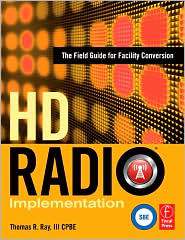
HD Radio Implementation: The Field Guide for Facility
Conversion, by Thomas R. Ray (Focal Press, $89.95) |
OK, let's acknowledge the elephant in the room: the rollout
of HD Radio, especially on the AM dial, has been one of the most
controversial issues in radio engineering in a very long time
- and Tom Ray, the outspoken director of engineering for Buckley
Broadcasting and New York's WOR, has been a lightning rod for
a lot of that criticism.
Ray doesn't shy from that criticism in this book, the first
hands-on guide to installing HD Radio and making it work. (Boston's
David Maxson covered much of the theory behind the system last
year in his The IBOC Handbook: Understanding HD Radio Technology,
also published by Focal.)
This is not a volume that's likely to find a mass audience,
especially as the troubled economy leads to a slowing down of
new HD installations, but any engineer who's even contemplating
adding a digital transmitter will want to have this book close
at hand as a friendly guide through the sometimes complicated
tasks of making all the new equipment work properly.
Even if you disagree - as we do - with some of Ray's conclusions,
especially on the touchy issue of nighttime AM HD interference,
this is still a useful volume to keep on the shelf. |
|

Icons of Talk: The Media Mouths That Changed America,
by Donna L. Halper (Greenwood Press, $75.00) |
Here's another one we haven't read yet, for the simple reason
that it's just been published - but for many NERW readers, that
"by Donna Halper" after the title should be enough
to draw their attention to this volume (which, by the way, should
be available shortly as a much less expensive paperback.)
In addition to her work as an author (this is her fourth book),
educator (currently at Lesley College) and consultant, Donna
is one of the driving forces behind our sister site, The Archives
@ BostonRadio.org - and of course she's one of the pre-eminent
broadcasting historians in America, period. (And did you know
she discovered the band Rush?)
Her latest work takes on talk radio, examining the history
of the medium all the way back to pioneers such as Joe Pyne,
Herb Jepko, and Boston's own Jerry Williams, putting them in
the social and political contexts of their eras and looking at
how they changed the worlds around them.
(Ask your local library to order a copy while you wait for
the paperback edition to come out...) |
|

Burning Up the Air: Jerry Williams, Talk Radio, and
the Life in Between, by Steve Elman and Alan Tolz (Commonwealth
Editions, $27.95) |
Speaking of Jerry Williams, this book, which we reviewed at
greater length back in our last "Bookshelf" installment
in March, is a must-read for anyone interested in the history
of talk radio or Boston radio or both.
Elman and Tolz, both former Williams producers, had access
to reams of his papers and hours upon hours of airchecks to craft
their story of a man who never believed he received the appreciation
he was due for his role in inventing modern talk radio, and they've
come up with a compulsively readable tale that paints a vivid
picture of talk radio then and now.
If you missed it earlier this year, catch it now (especially
in light of Williams' induction to the Radio Hall of Fame this
fall!) |
|

For the Love of Murphy's: The Behind-The-Counter Story
of a Great American Retailer, by Jason Togyer (Pennsylvania
State University Press, $34.95) |
Here's another one we haven't read yet, but we can certainly
vouch for the author: Togyer is one of our Pittsburgh correspondents
- and an occasional cartoonist - here at NERW, and he's been
chronicling his love of his hometown of McKeesport, Pennsylvania
for years at his Tube
City Almanac website.
In this volume, Togyer (whose day job is as an editor at the
University of Pittsburgh) turns his attention to G. C. Murphy's,
the five-and-ten-cent store that was based in McKeesport, where
it once rivaled giants like Woolworth's in a territory that stretched
across the mid-Atlantic states.
"Tube City" fans know that Togyer's both a great
writer and the most passionate fan of McKeesport that there is,
which should make this an interesting read even for those who
never shopped in a Murphy's store.
(Although if you're reading this in East Smethport, PA or
Rockville, MD, you might want to read Jason's warning
before placing your order...) |

Broadcast Towers: A Step-by-Step Guide to Making Money
on Vertical Real Estate, by Erwin G. Krasnow and Henry A. Solomon,
edited by Scott Fybush (NAB,
$39.95 e-book, $43.95 softcover + e-book) |
No pretense to impartiality here: this volume was edited by
yours truly, and it features a fine selection of tower photos
from our extensive collection.
That said, it would have earned a recommendation here anyway,
since it answers in great detail a question we often get here
at NERW - "I own a tower. How can I make money by leasing
out space on it?"
Krasnow, a former general counsel to the NAB, has become a
leading expert on that topic, and here he shares the knowledge
he's gathered alongside his fellow partner at the DC law firm
of Garvey, Schubert & Barer, Henry Solomon.
There's useful advice on everything from co-locating with
an AM station to dealing with pesky neighbors and local zoning
boards, not to mention several appendices filled with handy checklists
and helpful advice - and the book includes plenty of opinions
from other experts in the field, too. |
|

Tower Site Calendar 2009, photos and text by Scott Fybush
(Fybush Media, $18, free with professional NERW subscription) |
OK, this isn't technically a "book" - but it's printed
and bound and has lots of lovely pictures of transmitter facilities
near (WRCE Watkins Glen NY, WQEW New York) and far (KSL Salt
Lake City, KNBR San Francisco), not to mention plenty of dates
from broadcasting history in the northeastern U.S. and eastern
Canada.
It makes a great holiday gift for anyone interested in radio,
an even better corporate gift (contact us for bulk discounts!),
and best of all, your purchase helps to support the continued
production of NERW and Tower Site of the Week in these economically
parlous times...so if you're stocking up on some of these books
for your favorite radio person (or yourself), why not head over
to the Fybush.com Store
and add a calendar or two? |

The Radio Book, 2008-2009 Edition (Inside
Radio, $89.95, order at insideradio.com)
NRC AM Log, 27th Edition (National Radio
Club, $25.95, order at nrcdxas.org) |
It's certainly true that most of the information you'd ever
want or need can be found on the web these days, but sometimes
it's handy to have the entire radio spectrum neatly bound between
two covers, too.
The Radio Book is the successor to the M Street
Directory, drawing from the comprehensive M Street database
that's obsessively tended by a team of researchers based up in
Littleton, N.H. (That's also the source of the data for 100000watts.com,
where your editor toils as news editor.)
This year's edition is the 17th in the not-quite-annual series
(it skipped a few years in the mid-nineties), and its 900-plus
pages contain copious details on technical facilities, ownership,
personnel and even ratings for more than 14,000 AM and FM stations
in the U.S. and parts of Canada.
If AM DX is your bag, the annual AM Log from the National
Radio Club is an essential addition to the bookshelf each fall.
With comprehensive listings of everything on the AM dial in the
U.S. and Canada - even those remote low-power CBC relays up in
the Yukon - the Log contains some bits of information,
including operating hours, slogans and network affiliations,
that are hard to find compiled in any other single source.
(As for you FM fans, we're still waiting to see whether Bruce
Elving's FM Atlas, last published back in 2005, will be
returning in an updated version next year.) |
|
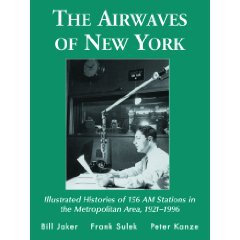
The Airwaves of New York: Illustrated Histories of 156
AM Stations in the Metropolitan Area, 1921-1996, by Bill Jaker,
Peter Kanze and Frank Sulek (McFarland & Co, paperback,
$35.00) |
This isn't a new book, technically speaking, since it came
out in hardcover back in 1998 - but since "Airwaves"
was released in paperback for the first time just a few months
ago, and since the original hardcover has been hard to obtain
for many years, it's worth a mention here.
Truly a labor of love, this wonderful volume details the individual
histories of pretty much every station that burst forth on the
New York AM dial in the medium's first 75 years, from big guns
like WEAF and WABC to forgotten flashes in the pan like WPCH
and WVFW. It's filled with rare photos and station schedules,
and the quality of the writing is a couple of cuts above what's
usually found in books of that ilk. (The credit for that is largely
due to Jaker, a producer at Binghamton's WSKG, who synthesized
all the research that came out of Kanze's and Sulek's voluminous
files.)
This one needs a disclaimer, too - while your editor wasn't
involved in (and derives no benefit from) this volume, there
will someday be a companion FM volume to "Airwaves,"
authorized by the creators of this book and assembled by yours
truly.
If all goes well, the FM book could even be our lead item
in next year's "Bookshelf" holiday edition... |
|
From
the NERW Archives
(Yup, we've been doing this a long time now, and
so we're digging back into the vaults for a look at what NERW
was covering one, five and ten years ago this week, or thereabouts
- the column appeared on an erratic schedule in its earliest
years as "New England Radio Watch," and didn't go to
a regular weekly schedule until 1997. Thanks to LARadio.com
for the idea - and thanks to you, our readers, for the support
that's made all these years of NERW possible!)
December 10, 2007 -
- When Cumulus' WFAS-FM (103.9 White Plains) filed to change
city of license to Bronxville back in January, it wasn't hard
to figure out what was coming next - a transmitter move that
would make the class A signal into a NEW YORK broadcaster.
- Here's what we said in NERW back on Feb. 5: As a pre-1964
grandfathered station, WFAS-FM doesn't have to protect its second-adjacent
neighbors on the Empire State Building, WKTU (103.5 Lake Success)
and WAXQ (104.3 New York), but it does have to stay at least
15 km from WPAT-FM (93.1 Paterson NJ), which is also on Empire.
That means it's likely to end up somewhere in the Bronx, where
it will probably end up joining another move-in, Cox's WCTZ (96.7
Stamford CT, moving to Port Chester NY).
- "Somewhere in the Bronx" turned out to be the tower
atop a Montefiore Medical Center building that's already home
to WFUV (90.7). Last week, WFAS-FM, which was granted the city-of-license
change to Bronxville over the summer, applied to move its transmitter
from its longtime site in Greenburgh to the WFUV tower (shown
below in 2005), where it would operate with 980 watts at 532
feet above average terrain. From that site, WFAS-FM would still
have decent Westchester/Rockland/north Jersey coverage, but more
to the point, it would blanket the Bronx and cover most of Manhattan,
Queens and even part of Brooklyn with a 60 dBu (city-grade) signal.
- What happens next? We speculated back in February that Cumulus,
which does most of its business in suburban and medium-sized
urban markets, was unlikely to keep WFAS-FM operating as a standalone
AC station in the cluster-dominated cauldron of Market Number
One, and last month's layoffs of a significant portion of WFAS-FM's
airstaff would seem to bear out that theory. Will WFAS-FM soon
be up for sale as a New York City signal? And if so, who would
be in line as buyers, at a price tag that's likely to be in the
$50 million range? It's not hard to imagine the new 103.9 nicely
complementing the Queens/Nassau rimshot of Univision's WQBU (92.7
Garden City), a signal for which Univision famously paid $60
million a few years ago. Then there's Citadel, whose two-station
cluster (WABC/WPLJ) is far smaller than those of its New York
competitors, CBS, Clear Channel and Emmis. Would Salem, which
is spinning off some of its smaller markets to focus on bigger
ones, want to add a "Fish" contemporary Christian FM
to its two AMs (WMCA and WWDJ)? Would Arthur Liu's Multicultural
group want an FM to go with its many AMs?
- In CONNECTICUT, Wayne Mulligan is stepping down at year's
end as general manager of Buckley Radio's WDRC (1360/102.9 Hartford),
where he's held that post since 1991. Mulligan came to WDRC in
1964 as an engineer, departing two years later to become an engineer
at WTIC (1080). He returned to WDRC in 1972 as chief engineer,
overseeing numerous expansions to the stations' facilities over
the years. He'll be succeeded as GM by Eric Fahnoe, who's currently
sales manager at the WDRC stations (as well as the nephew of
CEO Rick Buckley.)
- In MASSACHUSETTS, Principle Broadcasting is trying again
to move WESX (1230 Salem) from its longtime (and very valuable)
site in Marblehead to a location much closer to Boston. Back
in March, Principle applied to change WESX's city of license
to Saugus, relocating the transmitter to the tower of WLYN (1360
Lynn) and requesting a waiver because the new site wouldn't provide
full coverage of the new community. In early November, the FCC
let Principle know that it wouldn't grant the waiver, giving
WESX an opportunity to amend its application to fix the problem.
Now the station has done so, changing its proposal to specify
Nahant as the new city of license. This time, no waiver is required,
as WESX would cover Nahant fully by day, and would cover 89.1%
of the town with a nighttime interference-free signal.
- And we're very sorry to report the death on Thursday (Dec.
6) of Fred B. Cole, one of the last living links to Boston radio
in the pre-World War II era. Cole worked for WBZ and WNAC before
joining WHDH in 1946, where he spent 21 years playing big-band
tunes. Cole was inducted into the Massachusetts Broadcasters
Hall of Fame earlier this year. Cole, who lived his entire life
in Hingham, was 92; he's survived by wife Betsey and a large
family.
December 8/11, 2003 -
- The 528-foot tower of WMGX (93.1 Portland ME) and WYNZ (100.9
Westbrook ME), a landmark for drivers entering Portland on I-295,
collapsed Thursday afternoon about 1:30, apparently because a
guy wire snapped. WYNZ was able to return to the air from an
auxiliary site, but WMGX is off the air at press time. Nobody
was hurt in the collapse, but WCSH (Channel 6) reports several
cars were damaged in the parking lot next to the tower.
- One of the oldest callsigns in NEW YORK has returned home
to the facility it called home for decades. Buckley Broadcasting
took over operations of Syracuse's AM 1390 last Monday (Dec.
1), changing its call letters from WDCW back to WFBL. Those sequentially-assigned
calls first saw use in Syracuse in 1922 on the station that would
become 1390, and remained in place there until September 1993,
when Crawford Broadcasting bought the station and changed the
calls to reflect owner Donald Crawford's initials (and to match
Crawford's other religious outlets across upstate New York, too.)
When the WFBL calls went away in 1993, Buckley grabbed them -
and the standards format that had been in use on 1390 - and placed
them on what had been WSEN (1050), and there they remained, even
as AM 1050 dropped standards for talk in May 2002. As of last
week, though, the talk programming has moved to the higher-power
(5000 watts day and night, versus 2500 watts day/19 watts night
on 1050) operation on 1390 - and 1050, too, is back to its heritage
calls of WSEN. It'll be simulcasting oldies WSEN-FM (92.1 Baldwinsville)
eventually, we're told, though it was still simulcasting talk
with 1390 this past weekend.
- Downstate, the news is all about Radio People on the Move:
Pat St. John, the veteran jock who's called stations such as
CKLW, WRIF, WNEW-FM and WPLJ home, now has a new address on the
New York dial. After doing weekends and fill-ins on Infinity's
WCBS-FM (101.1) for the last few years, Pat kicked off his new
gig as Saturday morning host on Clear Channel classic rocker
WAXQ (104.3) this past weekend. Meanwhile, Q104's sister station
WLTW (106.7) signed midday host Valerie Smaldone to another long-term
contract last week. She's been part of Lite 106.7 since the station
flipped from country to AC more than twenty years ago - quite
a record of longevity in the turbulent New York radio world!
On the engineering side, Glynn Walden has joined Infinity as
VP/Engineering. Walden worked for two of Infinity's predecessors,
CBS and Westinghouse, in the same position before joining Ibiquity
Digital Radio, where his job was eliminated a few months ago.
And out on Long Island, veteran DJ Scott Miller lands at WALK-FM
(97.5 Patchogue) to do middays, replacing the departed Rick Martini.
Miller was last heard on WKJY (98.3 Hempstead).
- Just short of the decade mark at WJYY (105.5 Concord) in
NEW HAMPSHIRE's capital city, Harry Kozlowski has resigned his
job as PD there (and at Vox sister station WNHI as well.) He's
staying in the market and focusing his efforts on running new
LPFM WCNH-LP (94.7 Concord), which hopes to be on the air with
a 24/7 classical music format sometime in January. No replacement
has been named yet at WJYY/WNHI - and NERW wishes Harry all the
best in his efforts to show what LPFM was really meant to do.
- The upcoming New Hampshire presidential primary was enough
to keep northern New England from seeing NBC's Saturday Night
Live this past weekend. WHDH-TV (Channel 7) in Boston, WCSH (Channel
6) in Portland, WLBZ (Channel 2) in Bangor, WNNE (Channel 31)
in Hartford, VERMONT and WPTZ (Channel 5) in Plattsburgh, N.Y.
all pre-empted the show with Rev. Al Sharpton hosting, out of
concerns that it might trigger equal-time claims from his Democratic
opponents. The show did air on WWLP (Channel 22) in Springfield,
WJAR (Channel 10) in Providence and WVIT (Channel 30) New Britain-Hartford;
the others carried a "best of" Steve Martin rerun,
which we hear was quite a bit funnier than the Sharpton show
anyway.
December 11, 1998 -
- Despite protests from angry listeners, including a street
rally Wednesday (Dec. 9) that found several hundred of them dancing
on West 43rd Street, New York's WQEW (1560) is going forward
with plans to switch to Radio Disney at midnight December 27.
WQEW's owner, the New York Times Co., will reportedly receive
$40 million from Disney to lease the station for the next five
years. So far, no other station has come forward to pick up the
format used by WNEW until 1992 and WQEW ever since. Wanna know
what WQEW mainstays like Jonathan Schwartz think of the deal?
We would too -- but the Times has put a gag order on its employees
while the format change goes through.
- Meantime in the Big Apple, Chancellor Media dropped "Big
105" from WBIX (105.1) Friday night, Dec. 4. The new format
is "Jammin' Oldies," similar to what the company has
been doing with great success in Chicago, LA, and other markets.
New calls are sure to follow. And Chancellor has hired former
WNEW (102.7) jock and New York radio legend Scott Muni. Early
next year, he'll start doing a one-hour show weekdays at noon,
playing music and offering commentary and interviews. The show
will give midday jock Maria Milito a one-hour lunch break during
her shift. Yes, that was Muni who surfaced on WFAN (660) for
a guest slot talking sports last week...
- Elsewhere in NEW YORK, it's been a busy couple of weeks for
Jacor's "second tier" of stations in the Rochester
market. On Thanksgiving eve, they looked like this: WYSY (106.7
Irondequoit) and WISY (102.3 Canandaigua) simulcast very soft
AC as "Sunny 106." WMAX-FM (107.3, still licensed Honeoye
Falls but already ID'ing with its new South Bristol city of license)
was rhythmic CHR as "Jam'n 107." Then things began
shifting. First WYSY dropped the "Sunny" format and
began simulcasting "Jam'n" on the evening of Nov. 25
-- while WISY kept going as though nothing had changed. For a
week, in fact, WISY continued to ID as "Sunny 106"
and act as though it still had a sister station in Rochester.
The only thing missing was a legal ID. Finally, the voicetracks
caught up with reality, and WISY now IDs properly as "Sunny
102" -- but the soft AC and Delilah can't reach most Rochester
listeners anymore.
- Next up, "Jam'n." Monday afternoon (Dec. 7), it
began announcing "The End of Jam'n." And with all the
excitement of a roll of toilet paper being changed, the ID that
hit a few minutes after 5 PM was the first to call the station
"Kiss 107." And aside from adding a few more non-rhythmic
hits (Shawn Mullins, anyone?), nothing else has changed at WYSY/WMAX-FM.
The station still has no jocks, for starters. Why the new name?
Gee, we noticed Jacor's new Cincinnati CHR is called "Kiss
107" while we were there last week...
- One more Rochester-area note: WASB-FM (105.5 Brockport) was
heard testing for a few hours on Friday, November 27, with a
loop of country music -- but has not been heard since. When it
comes on for real, it will have a hard time in eastern Monroe
County, where Oswego's co-channel WTKV puts in a very respectable
signal on 105.5.
- Lots of news in New England, and we'll start with CONNECTICUT,
where WTNH (Channel 8) in New Haven became the Nutmeg State's
first DTV outlet with the debut of WTNH-DT (Channel 10) last
Friday (Dec. 4) at 9 AM. WTNH-DT will simulcast Channel 8's local
news while awaiting the availability of more HDTV programming
and equipment.
- Home shopping "en espanol" is on its way to southern
Connecticut, with the sale of Paxson's WBPT (Channel 43) in Bridgeport
to a company called "Cuchifritos Communications." They're
paying $22 million for the signal so they can use it as the first
outlet for "Compar de su Casa," which means (drumroll,
please) "Shop at Home." Paxson says it will sell all
its non-PaxTV outlets, which presumably means WHCT (Channel 18)
in Hartford is available as well.
- Next up, RHODE ISLAND, where the South County is losing a
local radio voice, but gaining NPR service, with Boston University's
purchase of WERI (1230 Westerly) from Bear Broadcasting. When
the $300,000 deal is complete early next year, WERI will become
WXNI, a 24-hour relay of WRNI (1290 Providence), which is itself
a relay of WBUR-FM (90.9 Boston) with some Rhode Island news
inserts in drive time. WBUR is promising more RI programming,
including a local talk show, in 2000. Meantime, WERI's Mark Urso
says the local programming from AM 1230, including a popular
weekend sports-talk show, will migrate to WERI-FM (99.3 Block
Island).
- A not-very-historic MASSACHUSETTS callsign is back on the
airwaves. The WBNW calls, which graced AM 590 from 1994 until
1997, resurfaced Dec. 1 on the former WADN (1120 Concord), where
they go with the business-talk format that replaced the late,
lamented "Walden Radio."
- Jerry Villacres is the new general manager of Mega's Boston-area
Spanish stations. WBPS (890 Dedham) and WNFT (1150 Boston) took
their new names and formats Dec. 1, becoming contemporary "Estrella
890" and CHurban "Mega 1150," respectively. Villacres
was president and GM of the now-defunct CBS Americas network.
- Down the Cape, WKPE (1170 Orleans) returned to the air this
month under new calls, becoming WFPB and relaying WUMB (91.9
Boston). WFPB(FM) in Falmouth, also 91.9, becomes WFPB-FM. (And
yes, that makes sense to the FCC, anyway...)
You
can sponsor this weekly feature! Click here for information! |
NorthEast Radio Watch is made possible by the generous
contributions of our regular readers. If you enjoy NERW, please
click here to
learn how you can help make continued publication possible. NERW
is copyright
2008 by Scott Fybush. |





